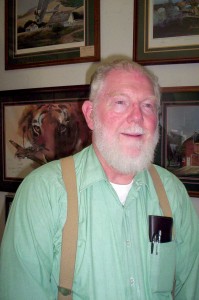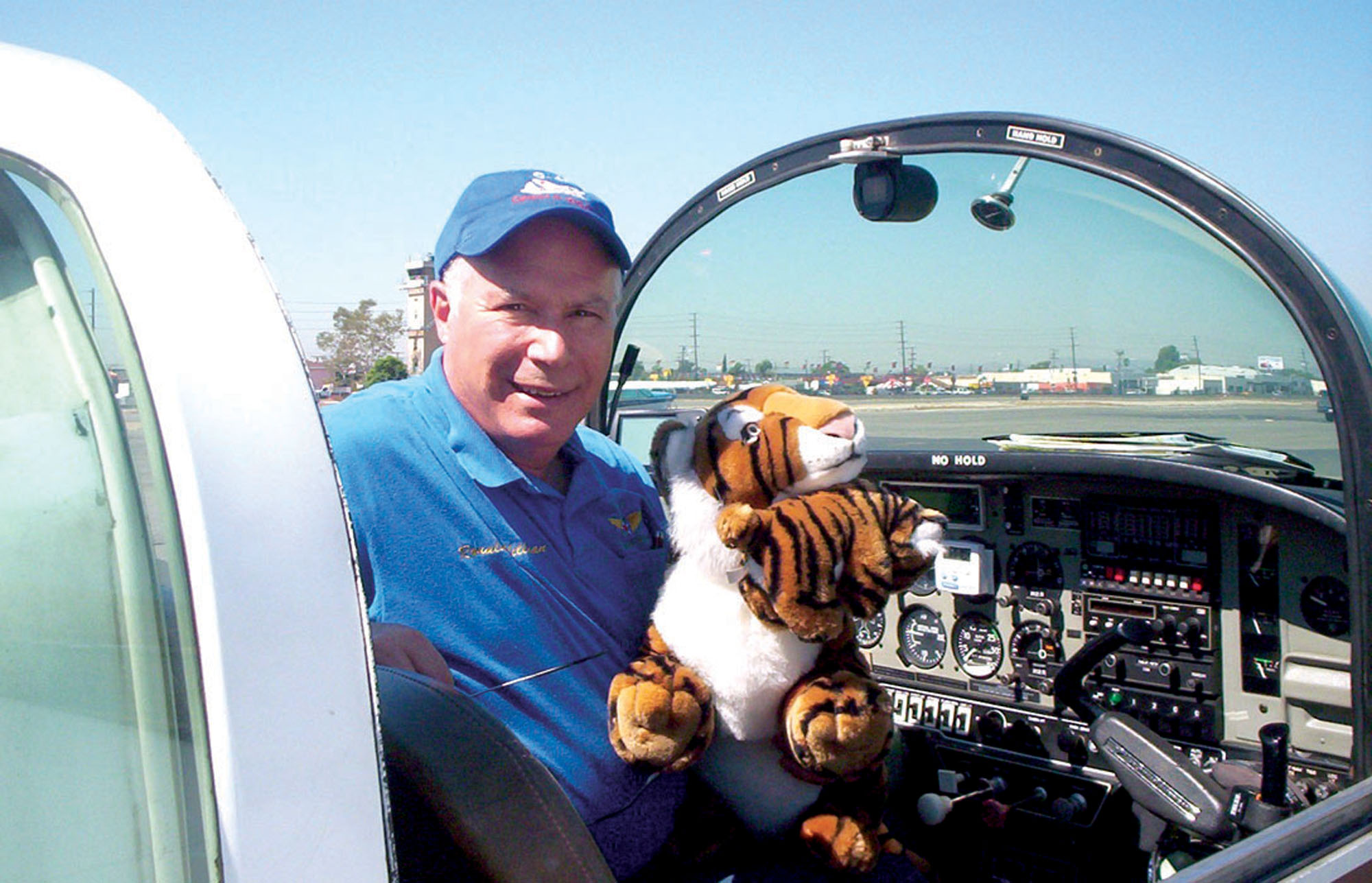By Fred “Crash” Blechman
“Well, is your plane ready to fly yet?” I asked Ron Millman. I knew that Ron had become a partner in a Grumman Tiger based at Whiteman Airport in Pacoima, and we had planned to go flying for a “Fred Baron” story. But his partners had grounded the plane at Camarillo Airport several weeks earlier after landing there with an engine problem.
“Not only is it ready to fly, but it’s flying better than ever since we had the plugs and magnetos changed,” replied Ron. “This Tiger really roars!”
We decided to fly to Cable Airport in Upland, just seven miles northwest of the large commercial Ontario Airport. I knew the owner of an aviation art gallery at the airport, and also a Commemorative Air Force wing is based there. Also, folks had told me about Maniac Mike’s Café at the airport, so there were several things to write about.
After pre-flighting and fueling low-wing Grumman Tiger N28560 at Whiteman Airport, Ron pulled back the sliding canopy and Lee “Slim” Auger climbed over the left cockpit sill into the back seats (his legs take up both back seats). Ron entered the pilot’s seat over the left sill, and I settled into the right front seat, and then snapped together the quick-release lap and shoulder belt combination. Snug, but comfortable, and with a terrific all-around view with the canopy pulled back. With a fixed tricycle gear, the low instrument panel and low nose of the Tiger provide excellent taxiing visibility.
Ron cranked up the engine, warmed it up, and taxied out to the run-up area. The altimeter was set to about 1,000 feet, fuel pressure and oil pressure OK. Sliding the canopy forward, but not closed, Ron tested the magnetos at 1,800 rpm. With a fixed-pitch propeller there was no need to cycle the prop pitch, and no manifold pressure gauge was used. Sliding the canopy forward and locking it, Ron took off at 11:20 a.m. from runway 12, with liftoff just over 60 knots, passing the airport tower at 75 knots.
The near visibility was good, but low ground haze kept forward visibility down to a few miles. With a left departure we took a 90-degree heading, climbing at 1,000 fpm at 105 knots (121 miles per hour) using 2,250 rpm. The large commercial Bob Hope Airport at Burbank was slightly to our right as we flew east paralleling the Foothill Freeway, which had little traffic on this Thursday just before noon. We climbed to 5,500 feet to get up above the haze and bumpy air. Even in a climb the nose of the Tiger is low enough for a great forward view–except for the ground haze. I took over the controls while Ron did all the radio communications–of which there are many in the crowded Los Angeles area. The Tiger flew effortlessly as we went almost directly over the Rose Bowl and the Santa Anita Racetrack on our way to Upland.
Cruising along at 115 knots (132 mph) at 2,250 rpm with the transponder set at 0222 for radar flight-following, we approached Cable Airport from the west, descended to 2,250 pattern altitude, flying downwind some distance as Ron announced our approach to Unicom. Ron took the controls, throttled back to 1,500 rpm and 80 knots on the base leg, then onto the final at 1,000 rpm and 70 knots, slowly pulling up the nose, and touching down at 60 knots at Cable’s 1,439-foot-high, 3,865-foot-long runway 24 at 11:50 a.m.–a half-hour flight. Cable Airport, incidentally, claims to be the “World’s Largest Family-Owned Public-Use Airport.”
Maniac Mike’s Café and CAF 3rd Pursuit Squadron
We parked the Tiger and found my old friend, Larry Bledsoe, waiting for us at his art gallery. Since it was almost lunchtime, we ambled over to Maniac Mike’s Cafe for lunch. Run by Michael and Annette Stewart, the restaurant was bustling with patrons. With a nice view of airport activity, and an aviation theme including large model airplanes suspended from the ceiling, Maniac Mike’s offers an extensive menu at reasonable prices. Michael Stewart, with his large black “Magnificent Men in their Flying Machines” mustache, is also the vice president of the airport.
After a pleasant lunch, Larry took us on a brief tour of the facilities of the Commemorative Air Force’s 3rd Pursuit Squadron. The wing is named after the late Erik Shilling, who was a P-40 pilot in the 3rd Pursuit Squadron of the famous “Flying Tigers” in China during WWII. A large Quonset hut and another building hold the meeting room, airplane models, pictures and memorabilia associated with squadron activities. Outside sat “Big Panda,” the squadron’s Antonov AN-2 Colt. Rides are offered in the large, single-engine yellow biplane at air shows all around Southern California.
Bledsoe’s Aviation Art
We then went back to Bledsoe’s Aviation Art, a gallery full of books, documentation, models and large, beautifully-framed aviation art. Larry originally started at the airport in 1988; in July 1990, a hangar became available.
“I spent the next three months getting it fixed up so the shop right here has been open since November of 1990,” Larry explained.
Although the gallery is primarily for selling aviation art and custom framing, it’s also used for selling new and used books, and is the corporate headquarters for BAC Publishing, Inc., Larry’s publishing business. Custom framing is only available at the shop, because of packaging and shipping problems.
Larry is also a writer who has had a couple of hundred articles published since 1989. He created and published Aviation Art Gallery magazine and created other aviation magazines.
“I love writing and I love aviation art and aviation history,” he said.
He’s also involved with the Southern California Friends of the American Fighter Aces.
“I do their newsletter and I’m their chaplain,” he said. “I also do the newsletter for the Inland Empire Wing of the CAF at Riverside.”
Larry, a private pilot, flew out of Cable Airport in the 1970s.
“During air shows here we used to have artists,” he said. “One year we had Saburo Sakai (a famous Japanese WWII ace) for one of his rare American appearances. We had him here signing his book and a print at that time. He’s since passed away.”
Erik Shilling and Larry were good friends.

Larry Bledsoe’s aviation art gallery at Cable Airport is also the headquarters for his BAC Publishing corporate office.
“He used to come here and sit in this chair,” Larry said. “He’d come in and we’d talk about flying; I encouraged him to write his own book. At that time, he was almost 80 years old. He had to learn how to use a computer, but he wrote his own book. He did the layout himself, and went out and self-published the book.”
The book’s title is “Destiny–A Flying Tiger’s Rendezvous with Fate.” “Destiny” and “Thunderbolt: Memoirs of a World War II Fighter Pilot,” by Marvin Bledsoe (Larry Bledsoe’s distant cousin), are available from Bledsoe’s Aviation Art.
Larry’s BAC Publishing has published several books, including “America’s Pioneer Aces,” by James H. Farmer, which primarily focuses on World War I aces Eddie Rickenbacker and Frank Luke, and “Son of a Preacher–A Hellcat Ace’s Memoirs,” by Lt. Cdr. E.C. “Carl” Hargreaves.
BAC’s newest book, due out by Christmas, is “Surplus U.S. WWII Aircraft,” by William Larkins.
“It’s a pictorial book, showing different aircraft and what happened to a lot of them,” Larry explained. “It’s a collection of information that’s not available in any one source now. In the appendices, it lists all the different locations where surplus aircraft were, and their disposition, and some of the aircraft that survived. Bill Larkins has been photographing aircraft since 1946, has published about six books, and is one of the founding members of the American Aviation Historical Society.”
After this pleasant visit, Lee, Ron and I climbed back into the Tiger and headed back to Whiteman Airport, with Ron taking off from Cable at 2:10 p.m. I climbed to 4,500 feet on a heading of 270 degrees, cruising at almost 140 miles per hour with a gas consumption of 10.4 miles per gallon. Flying south of the 210 Foothill Freeway with the San Gabriel Mountains to our right, we flew over many small cities, like Claremont, LaVerne, Covina, Baldwin Park and Arcadia, before Pasadena and Glendale. With the sun getting lower in the sky ahead of us, the haze limited forward visibility, so Ron took over the controls, altered our heading to Whiteman and “greased it on” at 2:35 p.m., touching down just as the stall warning sounded.
For more information about Cable Airport, visit [http://www.cableairport.com]. Visit BAC Publishers at [http://www.bac-publishers.com] and Bledsoe Aviation Art at [http://www.bledsoesavart.com].












